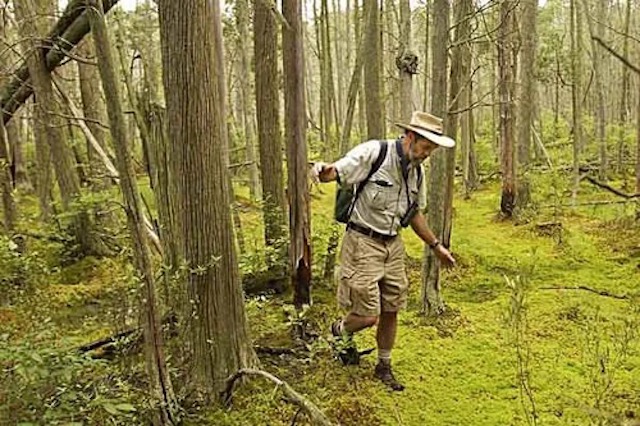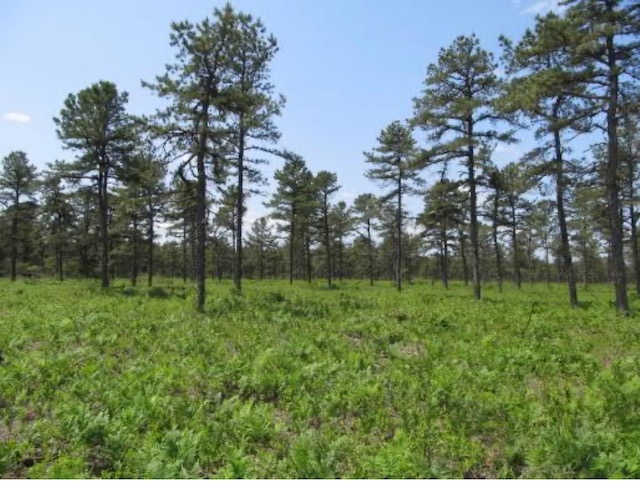Decade Long Campaign Shows How Conservationists Have Been Duped
Strong public opposition and honest advocacy have stopped the loggers
(Caption: Russell Juelg, who takes hikers through the BATONA TRAIL, navigaqtes the pine bog around the Batona trail near Carranza Road in Wharton State Forest. Photo: Michael Bryant)
For over a decade, economic and DEP bureaucratic interests have attempted to pass legislation to promote and expand highly unpopular logging of NJ forests.
Those efforts have been supported by the powerful chairman of the Senate Environment Committee, Bob Smith, (D, Middlesex County. Not a lot of forest there.)
The slogans and dubious scientific rationales used to support those logging campaigns have varied over time in a continuing barrage of bills: “forest harvest”, “forest stewardship” “forest health”, “young forests”, “sustainable forests”, creation of habitat, diversify single age class forests, control diseased insect infested forests, et al.
We see the most recent attempt happening right now in the Pinelands under the pretext of preventing wildfire.
No doubt, the emerging and next pretext will be generated by Senator Smith’s Forestry Taskforce and involve carbon credits, carbon trading, or some derivative scheme of a faux response to the climate emergency.
Thankfully, those efforts have failed – but not as a result of opposition from NJ’s leading conservation groups. Some, like NJ Audubon, have openly supported logging legislation, while others take a more nuanced but equally misguided approach to support logging.
But other independent advocates – with no economic, organizational, or political interests in logging – have remained vigilant and steadfast in strongly opposing and clearly warning the public about the harm these bills would do to our magnificent public lands and forests.
(I used to be able to count on the support of groups like Environment NJ and NJ Sierra Club, but no longer. They too are in the tank with corrupt groups like Exxon Mobil and Trump backed NJ Audubon and apparently have drank the logging Kool-aid from NJCF and PPA).)
There is a timely lesson to be learned from that history, specifically as it relates to the current debate over DEP’s plan to log the Pinelands.
These lessons are perfectly illustrated in a 9 year old story by veteran NJ Spotlight reporter Tom Johnson (Philadelphia Inquirer version, 6/12/13):
New Jersey is looking to open up logging on state lands, most of which were largely acquired through Green Acres bond issues and other public funds.
In an issue that once again is splintering the environmental community, a bill (A. 2837) allowing the Department of Environmental Protection to develop a harvest program on state-owned lands won bipartisan approval Monday from a legislative committee. ….
Instead of being a forest harvest program, the amendments make the bill a forest stewardship program, according to Elliot Ruga, a senior policy analyst for the New Jersey Highlands Coalition. His organization opposed previous versions of the legislation but backs the new bill.
But Bill Wolfe, executive director of the New Jersey chapter of Public Employees for Environmental Responsibility, argued the bill lacked adequate safeguards to protect public lands.
“Just 10 years ago, the Legislature enacted the Highlands Act to prevent fragmentation of forests,” he told the Assembly Agriculture and Natural Resources Committee. “It’s moving in a completely different direction.” …
Even with its many critics, both measures were endorsed by some of the more influential conservation organizations in the state, including the New Jersey Audubon Society, the New Jersey Conservation Foundation, and the Pinelands Preservation Alliance – as well as the New Jersey Farm Bureau.
The same conservation groups are either openly supporting or not opposing the DEP plan to log the Pinelands. They must be stopped.
So, to mix a metaphor and beat a dead old adage: those that don’t learn from history ……..
(and take a look below at the Pinelands forests they are trying to create via “thinning” and “feathering” “treatments” – compare it to the forest you see in the photo above:


